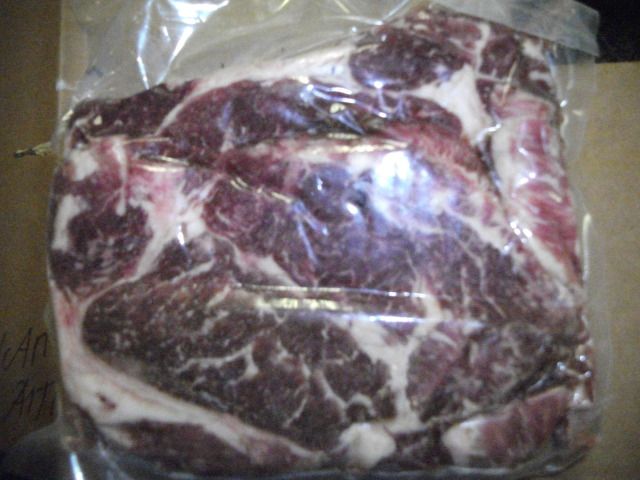Allfarmer you had some interesting quotes in your
posts that I'd like to give my opinion on:
"....I guess it's the angus beef"
If you believe that you are victim of the biggest
marketing campaign in the history of the red meat
industry. The Angus breed is so generic that the
name in association with quality meat means nothing.
You might get a great Angus steak or you might get a
Charolais one seeing how most Angus breeder are
selecting for Charolais not Angus characteristics. Do
you notice that Angus with marbling characteristics
are the in demand thing now? When they lost
marbling in pursuit of Charolais growth
characteristics we are expected to believe that didn't
affect meat quality? Most of these Angus programs
are based on only hide color anyway with no genetic
ancestry correlation. So it depends more on how it
was raised than what the pedigree says - when there
is no longer a breed type associated with the breed
named on the said certificate.
"We had a steer here that was born and finished
here completely on grass....zero grain.
This stuff is at least 40 percent better
than store bought beef."
Thats quite a recommendation for grass-fed beef. I'm
happy you enjoyed it although I find its hard to be
subjective when comparing my own product to
others. I use an independent taste tester for
comparison purposes.
"They feed a bit of grain 2 months prior to
butchering to add flavor."
This comment you included about a fellow ranchers
product rather contradicts your own findings on
grass-fed. Grain adds flavour? really? I thought grain
taste was the taste of bland - the taste of store
bought chicken, pork or beef. Where good grass-fed
beef is different is that it does have taste reflecting a
diverse diet of different types of vegetation. Grain fed
beef is mono-culture barley and barley silage flavour.
Now some will say they don't like the taste of grass-
fed and find it gamey - that is maybe true of poorly
raised grass-fed of which there is plenty around but
it is not true of the good stuff. To produce a quality
grass-fed product the grass skills are more important
than the genetics in my opinion. My proof of that
would be a dairy farmer I know with exceptional grass
skills and knowledge. I've tasted beef off a 2 year
open holstein heifer he raised and it's about the
closest thing I've tasted to my own product.
Considerably better than some of the branded Angus
beef I've tasted over the years both here and abroad.
You have got to understand the lignification process
and the energy and protein content of forages and
how to manipulate them through grazing
management before you can produce good grass-fed
beef and these skills are severely lacking in AB in my
experience.
posts that I'd like to give my opinion on:
"....I guess it's the angus beef"
If you believe that you are victim of the biggest
marketing campaign in the history of the red meat
industry. The Angus breed is so generic that the
name in association with quality meat means nothing.
You might get a great Angus steak or you might get a
Charolais one seeing how most Angus breeder are
selecting for Charolais not Angus characteristics. Do
you notice that Angus with marbling characteristics
are the in demand thing now? When they lost
marbling in pursuit of Charolais growth
characteristics we are expected to believe that didn't
affect meat quality? Most of these Angus programs
are based on only hide color anyway with no genetic
ancestry correlation. So it depends more on how it
was raised than what the pedigree says - when there
is no longer a breed type associated with the breed
named on the said certificate.
"We had a steer here that was born and finished
here completely on grass....zero grain.
This stuff is at least 40 percent better
than store bought beef."
Thats quite a recommendation for grass-fed beef. I'm
happy you enjoyed it although I find its hard to be
subjective when comparing my own product to
others. I use an independent taste tester for
comparison purposes.
"They feed a bit of grain 2 months prior to
butchering to add flavor."
This comment you included about a fellow ranchers
product rather contradicts your own findings on
grass-fed. Grain adds flavour? really? I thought grain
taste was the taste of bland - the taste of store
bought chicken, pork or beef. Where good grass-fed
beef is different is that it does have taste reflecting a
diverse diet of different types of vegetation. Grain fed
beef is mono-culture barley and barley silage flavour.
Now some will say they don't like the taste of grass-
fed and find it gamey - that is maybe true of poorly
raised grass-fed of which there is plenty around but
it is not true of the good stuff. To produce a quality
grass-fed product the grass skills are more important
than the genetics in my opinion. My proof of that
would be a dairy farmer I know with exceptional grass
skills and knowledge. I've tasted beef off a 2 year
open holstein heifer he raised and it's about the
closest thing I've tasted to my own product.
Considerably better than some of the branded Angus
beef I've tasted over the years both here and abroad.
You have got to understand the lignification process
and the energy and protein content of forages and
how to manipulate them through grazing
management before you can produce good grass-fed
beef and these skills are severely lacking in AB in my
experience.
 </a>
</a>
Comment